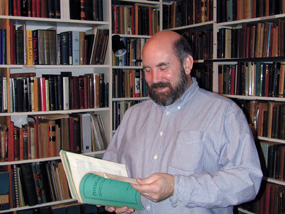 John Ptak looks through one of the journals of yesteryear. (Photo by: Alan Chodos/APS) |
"We are probably the largest sellers of used, out-of-print, scarce, unobtainable and non-existent books in science and mathematics" says Ptak, "not to mention manuscripts, reprints, journals, maps and prints."
A visit to Ptak's establishment at the corner of 33rd and (appropriately enough) Volta Streets in Washington tends to support his claim. The floor-to-ceiling shelves are crammed with volumes both old and fairly recent, jostling each other for space. Books and journals sway precariously in tall piles in the corners, and occasionally come skidding down across the floor. Prints and maps line walls and fill cabinets. Other artifacts, such as an artificial skeleton, a microscope and a set of test tubes, pop up in odd places.
Ptak prefers to buy books, journals, pamphlets and other material in large lots. He then "mines" them for the fraction that has resale value. These are stored both in Georgetown and in a warehouse that Ptak maintains in nearby Maryland. He has "many hundreds, if not over a thousand" older volumes of the Physical Review for sale, and the price depends on what's in them. For example, the issue dated April 1, 1948, containing the famous paper by Alpher, Bethe and Gamow, sells at a premium compared to other numbers in the same volume. Other issues on display date back to the early years of the 20th century, some bearing the signature of Clinton Davisson of the Davisson-Germer experiment. In those days the Physical Review printed only about a hundred pages a month, and the research articles were sandwiched between ads for books and equipment in the front and back.
Ptak is particularly proud of his collection of books and journals on quantum mechanics and quantum electrodynamics. He has hundreds of items for sale, including as one example a first edition of Schiff's book on quantum mechanics, complete with its original dust jacket. Ptak is selling it for $75, whereas the dust jacket reveals that it fetched $5.50 in 1949 when it was new.
Ptak thinks most of his items are real bargains. "Baseball cards or comic books of this vintage and in this condition would sell for ten times as much," he says. "Anyone with a job can afford what I sell."
February 2001 (Volume 10, Number 2)
Articles in this Issue

